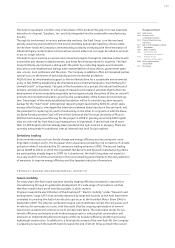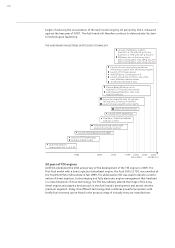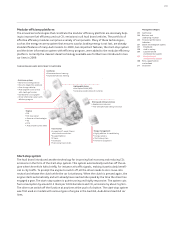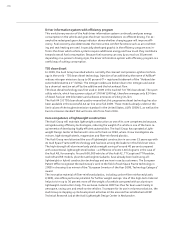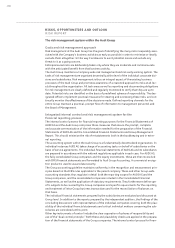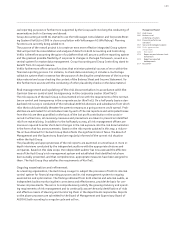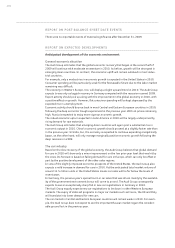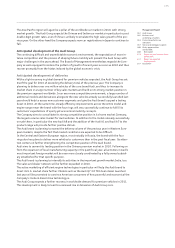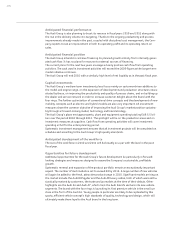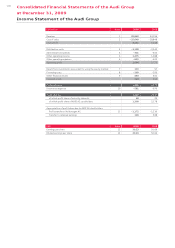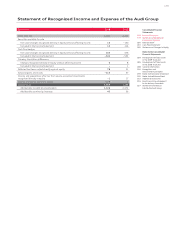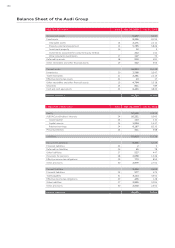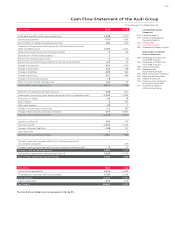Audi 2009 Annual Report Download - page 175
Download and view the complete annual report
Please find page 175 of the 2009 Audi annual report below. You can navigate through the pages in the report by either clicking on the pages listed below, or by using the keyword search tool below to find specific information within the annual report.
172
Further disruption in the production process could be caused by supply delays or non-delivery as
a result of tool breakage, losses from natural disasters and strikes at suppliers or in the trans-
portation sector.
The financial and economic crisis has also led to growing financial problems at individual suppli-
ers and dealers, in some cases leading to their insolvency. The Audi Group limits such risks by
implementing detailed supplier selection, monitoring, steering and supporting processes.
The automotive industry’s increasingly close partnerships between manufacturers and suppliers
bring both economic benefits and growing dependence. This trend is receiving added momen-
tum from the exclusive use of innovative technologies created by globally active suppliers. The
Audi Group addresses the resulting risks for example by defining appropriate contractual terms
or retaining title over tools used by third-party companies.
The Audi Group is substantiating its status as an innovative manufacturer of premium vehicles
by gradually broadening its product range and entering a large number of new product seg-
ments. It not only plans meticulously, but also commissions numerous market studies to under-
pin the decision-making process for new vehicle projects. Notwithstanding these thorough
preparations, a model’s market success is not always a foregone conclusion.
Furthermore, the development of new vehicles and components carries with it a number of
other potential risks. In addition to delays and changes to the product at short notice, these
primarily concern the loss of expertise to service providers outside the Group. The Audi Group
protects itself against this risk by consciously selecting reliable system partners and methodi-
cally safeguarding its intellectual proprietorship of core competencies.
Legal risks
The current legal framework is the basis for all activities by the corporate bodies, management
personnel and employees of the Audi Group. The Company therefore takes all necessary meas-
ures to ensure that the legal requirements are complied with. In addition to preparing Group-
wide codes of conduct, in particular it provides regular employee training on new legal require-
ments.
Nevertheless, the growing complexity of legal requirements, the expansion of business activities
and the high international spread of the Audi Group means there is an increasing risk of unlaw-
ful acts being committed unwittingly. Moreover, it is impossible to rule out deliberate misde-
meanors by individual persons. The Audi Group has actively countered these risks by installing a
compliance organization.
All premium vehicles built by the Audi Group aspire to satisfy the exacting quality requirements
of customers. As in any company, there is nevertheless the possibility of product liability claims.
In addition to causing serious damage to the Company’s image, these can have major financial
consequences, particularly if they lead to lawsuits in the U.S. market. The Audi Group counter-
acts such risks by maintaining high quality standards for its products and tackling quality man-
agement systematically. It moreover guards against such risks by taking out appropriate insur-
ance cover and setting aside economically advisable sums as provisions.
The Audi Group is not currently involved in any legal or arbitration proceedings that could have a
lasting impact on the economic position of the Group.
Personnel risks
The success of the Audi Group as a manufacturer of technologically pioneering, high-quality
premium vehicles will continue to depend to a high degree on the commitment and qualifica-
tions of its specialists and managers. Targeted human resources development and further train-
ing for the workforce are therefore a priority area of human resources management. The Com-
pany also enjoys an outstanding reputation as an attractive employer, giving it a head start in
the race to attract well-qualified employees. Furthermore, its broad training program facilitates
the securing of junior personnel for specific tasks.



